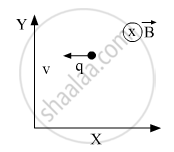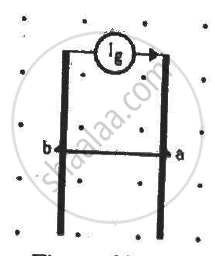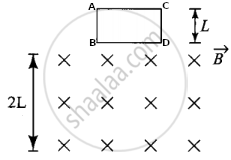Advertisements
Advertisements
प्रश्न
Consider the situation shown in figure. The wire PQ has mass m, resistance r and can slide on the smooth, horizontal parallel rails separated by a distance l. The resistance of the rails is negligible. A uniform magnetic field B exists in the rectangular region and a resistance R connects the rails outside the field region. At t = 0, the wire PQ is pushed towards right with a speed v0. Find (a) the current in the loop at an instant when the speed of the wire PQ is v, (b) the acceleration of the wire at this instant, (c) the velocity vas a functions of x and (d) the maximum distance the wire will move.

उत्तर
(a) When wire PQ is moving with a speed v, the emf induced across it is given by
e = Blv
Total resistance of the circuit = r + R
∴ Current in the circuit, \[i = \frac{Blv}{r + R}\]
(b) Force acting on the wire at the given instant, F = ilB
On substituting the value of i from above, we get
\[F = \frac{(Blv)(lB)}{(R + r)} = \frac{B^2 l^2 v}{R + r}\]
Acceleration of the wire is given by
\[a= \frac{B^2 l^2 v}{m (R + r)}\]
(c) Velocity can be expressed as:-
\[v = v_0 + at = v_0 - \frac{B^2 l^2 v}{m (R + r)}t..........\left(\text{As force is opposite to velocity}\right)\]
Velocity as the function of x is given by
\[v = v_0 - \frac{B^2 l^2 x}{m (R + r)}\]
(d) \[a = v\frac{dv}{dx} = \frac{B^2 l^2 v}{m (R + r)}\]
\[dx = \frac{m (R + r)}{B^2 l^2}dv\]
On integrating both sides, we get
\[x = \frac{m(R + r) v_0}{B^2 l^2}\]
APPEARS IN
संबंधित प्रश्न
Find the condition under which the charged particles moving with different speeds in the presence of electric and magnetic field vectors can be used to select charged particles of a particular speed.
Depict the behaviour of magnetic field lines in the presence of a diamagnetic material?
A point charge q moving with speed v enters a uniform magnetic field B that is acting into the plane of the paper as shown. What is the path followed by the charge q and in which plane does it move?
If an electric field \[\vec{E}\] is also applied such that the particle continues moving along the original straight line path, what should be the magnitude and direction of the electric field \[\vec{E}\] ?

Sketch a schematic diagram depicting oscillating electric and magnetic fields of an em wave propagating along + z-direction ?
The motion of copper plate is damped when it is allowed to oscillate between the two poles of a magnet. What is the cause of this damping?
Two long straight parallel conductors carrying steady currents I1 and I2 are separated by a distance 'd'. Explain briefly, with the help of a suitable diagram, how the magnetic field due to one conductor acts on the other. Hence deduce the expression for the force acting between the two conductors. Mention the nature of this force.
Two proton beams going in the same direction repel each other whereas two wires carrying currents in the same direction attract each other. Explain.
Consider a long, straight wire of cross-sectional area A carrying a current i. Let there be n free electrons per unit volume. An observer places himself on a trolley moving in the direction opposite to the current with a speed \[v = \frac{i}{\text{nAe}}\] and separation from the wire by a distance r. The magnetic field seen by the observer is very nearly
Consider the situation shown in figure. The wires P1Q1 and P2Q2 are made to slide on the rails with the same speed 5 cm s−1. Suppose the 19 Ω resistor is disconnected. Find the current through P2Q2 if (a) both the wires move towards right and (b) if P1Q1 moves towards left but P2Q2 moves towards right.

The current generator Ig' shown in figure, sends a constant current i through the circuit. The wire ab has a length l and mass m and can slide on the smooth, horizontal rails connected to Ig. The entire system lies in a vertical magnetic field B. The system is kept vertically in a uniform horizontal magnetic field B that is perpendicular to the plane of the rails (figure). It is found that the wire stays in equilibrium. If the wire ab is replaced by another wire of double its mass, how long will it take in falling through a distance equal to its length?

If an electron is moving with velocity `vecnu` produces a magnetic field `vec"B"`, then ______.
Assertion(A): A proton and an electron, with same momenta, enter in a magnetic field in a direction at right angles to the lines of the force. The radius of the paths followed by them will be same.
Reason (R): Electron has less mass than the proton.
Select the most appropriate answer from the options given below:
A moving charge will gain kinetic energy due to the application of ______.
A beam of protons with speed 4 × 105 ms-1 enters a uniform magnetic field of 0.3 T at an angle of 60° to the magnetic field. The pitch of the resulting helical path of protons is close to :
(Mass of the proton = 1.67 × 10-27 kg, charge of the proton = 1.69 × 10-19 C)
A square coil ABCD with its plane vertical is released from rest in a horizontal uniform magnetic field `vec"B"` of length 2L. The acceleration of the coil is ______.

A charge Q is moving `vec"dl"` distance in the magnetic field `vec"B"`. Find the value of work done by `vec"B"`.
